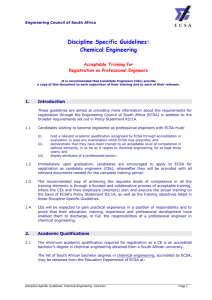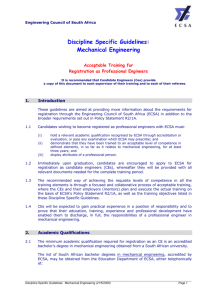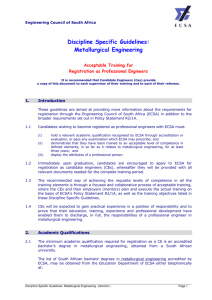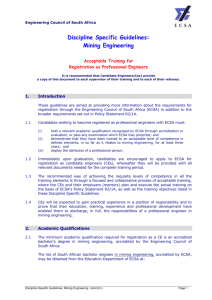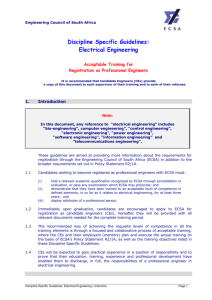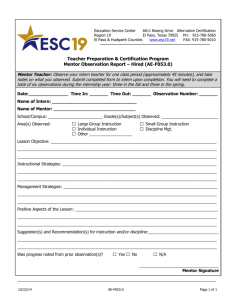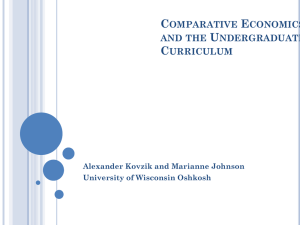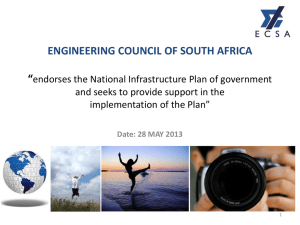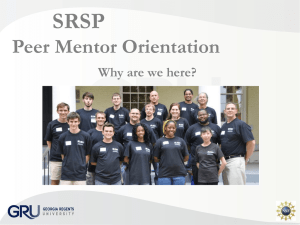Discipline Specific Guidelines: Industrial Engineering
advertisement
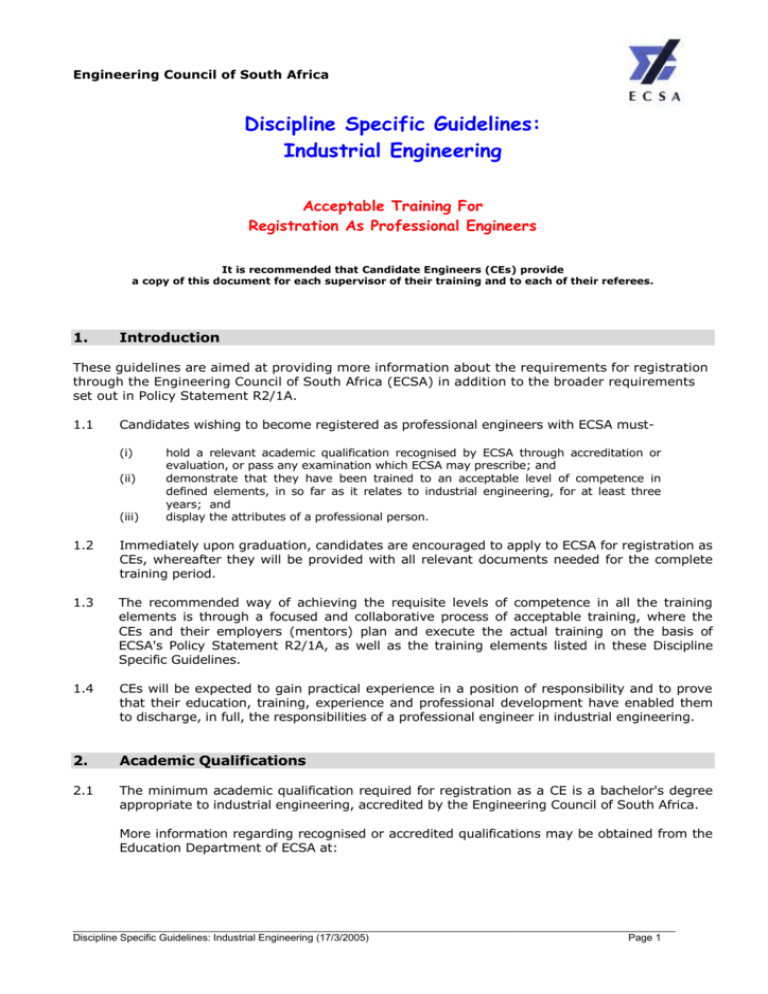
Engineering Council of South Africa Discipline Specific Guidelines: Industrial Engineering Acceptable Training For Registration As Professional Engineers It is recommended that Candidate Engineers (CEs) provide a copy of this document for each supervisor of their training and to each of their referees. 1. Introduction These guidelines are aimed at providing more information about the requirements for registration through the Engineering Council of South Africa (ECSA) in addition to the broader requirements set out in Policy Statement R2/1A. 1.1 Candidates wishing to become registered as professional engineers with ECSA must(i) (ii) (iii) hold a relevant academic qualification recognised by ECSA through accreditation or evaluation, or pass any examination which ECSA may prescribe; and demonstrate that they have been trained to an acceptable level of competence in defined elements, in so far as it relates to industrial engineering, for at least three years; and display the attributes of a professional person. 1.2 Immediately upon graduation, candidates are encouraged to apply to ECSA for registration as CEs, whereafter they will be provided with all relevant documents needed for the complete training period. 1.3 The recommended way of achieving the requisite levels of competence in all the training elements is through a focused and collaborative process of acceptable training, where the CEs and their employers (mentors) plan and execute the actual training on the basis of ECSA's Policy Statement R2/1A, as well as the training elements listed in these Discipline Specific Guidelines. 1.4 CEs will be expected to gain practical experience in a position of responsibility and to prove that their education, training, experience and professional development have enabled them to discharge, in full, the responsibilities of a professional engineer in industrial engineering. 2. Academic Qualifications 2.1 The minimum academic qualification required for registration as a CE is a bachelor's degree appropriate to industrial engineering, accredited by the Engineering Council of South Africa. More information regarding recognised or accredited qualifications may be obtained from the Education Department of ECSA at: _________________________________________________________________________________________________________ Discipline Specific Guidelines: Industrial Engineering (17/3/2005) Page 1 Tel: Fax: E-mail: Web: (011) 607-9500 (011) 622-9295 engineer@ecsa.co.za www.ecsa.co.za Private Bag X691 Bruma 2026 or in writing at: 2.2 Persons who have graduated from a university not accredited by ECSA will be assessed individually on merit. If their qualifications are evaluated as being at least equivalent to an accredited South African degree, candidates will be eligible for registration as CEs and could then follow the formal route to registration as professional engineers. 2.3 Persons whose qualifications are not accredited or recognised by ECSA may follow an alternative route to meet the academic requirements for registration as CEs. Candidates must apply to ECSA and obtain the necessary information on the procedure to be followed. 2.4 Those who meet ECSA's academic requirements should register as CEs without delay. Application forms can be obtained from ECSA. CEs must, from the outset, also obtain copies of the application form for registration as professional engineers. 3. Training and Professional Development Undertaking (CU), and Mentorship under a Commitment and Commitment and Undertaking (CU) 3.1 CEs must persuade their employers to register a Commitment and Undertaking with ECSA, namely that they will structure the training of, and actually train, their CEs, in accordance with the requirements of ECSA's Policy Statement R2/1A as well as the requirements set out in these Discipline Specific Guidelines. Each CU will be allocated a permanent registration number, which should be quoted by all CEs when applying for registration as professional engineers. 3.2 Employers must, at the same time, submit the name(s) of a mentor(s) from within the organisation (see 3.4 below) or, if an internal mentor is not available, the name of an external mentor (see 3.5 below) to guide CEs through the required process of training. A CU will not be registered by ECSA unless the name of at least one mentor (internal or external) is provided. Mentorship and Supervision 3.3 ECSA and the Southern African Institute for Industrial Engineering (SAIIE) will jointly maintain a list of internal and external mentors. A mentor must be registered as a professional engineer. Council will only in exceptional cases consider the listing of experienced and mature professional engineering technologists, professional certificated engineers, or professional engineering technicians, upon application and motivation by the organisation/mentor concerned. These mentors will be deemed not only to be capable of fulfilling their functions in a professional manner but also as being committed to advising and guiding their CEs in their professional development. 3.4 It is STRONGLY RECOMMENDED that all CEs should have a mentor who is working in the same organisation as the CEs (internal mentor). 3.5 If an internal mentor is not available, a list of external mentors can be obtained from ECSA or SAIIE. It will be expected of employers who make use of the services of external mentors to create an environment in which such mentors can feel free to make recommendations in the reasonable knowledge that their recommendations will be given sympathetic consideration. _________________________________________________________________________________________________________ Discipline Specific Guidelines: Industrial Engineering (17/3/2005) Page 2 3.6 It will be expected of all mentors to become fully conversant with their functions and responsibilities referred to in Policy Statement R2/1A and guidelines issued by ECSA from time to time, to conduct regular discussions with their CEs and to assess their progress in accordance with the guidelines set out in Policy Statement R2/1A and these Discipline Specific Guidelines. Since the effectiveness of mentors will be monitored continuously, Council will attach much value to the opinion of "the conscientious mentor" as to the registrability (or otherwise) of their CEs. 3.7 It is not expected of mentors to take responsibility for the day to day supervision and training of CEs. Mentors/employers should do everything in their power to ensure that competent persons, preferably registered with ECSA, are available to oversee this function as supervisors. 4. General 4.1 Training reports, which must be updated regularly, form an essential part of the monitoring process, and these reports must be filled in on the correct forms (Forms A2.1 and A2.2) of the application form. These forms are part of the application form and should be obtained from ECSA as soon as the CEs start their training. 4.2 It is a requirement that CEs who are aspiring to become professional engineers should, with the assistance of their mentors, achieve their training objectives by structuring their training in such a way as to cover the various elements of training referred to in Policy Statement R2/1A and these Discipline Specific Guidelines. 4.3 The rate at which CEs progress through their training is determined by themselves, their mentors and other factors such as the state of the economy and availability of training opportunities. 4.4 Where CEs, training under a CU decide to change employers, they should ensure that they continue their training under another CU registered with ECSA by their new employers. CEs should also ensure that their new employers provide mentors to guide them through the remainder of their training period and to take over where the previous mentor ended. It may even be advisable to retain the previous mentor, if this is at all practicable. 4.5 Once all the objectives have been achieved to the satisfaction of the mentor, CEs should, in principle be registerable, and could then apply for registration as professional engineers. Depending on the circumstances, CEs may expect to take a minimum of three years to achieve acceptable competence in all the prescribed elements. 4.6 Regardless of whether or not CEs train under a CU, it is recommended that they strive to participate in a process of continuing learning. This concept includes continuing education and professional development. 4.7 Continuing learning may include the attending of courses, technical conferences, seminars, symposia, organised site visits, as well as meetings of professional bodies and self-study. The process of continuing learning should achieve a balance between technical content and managerial/professional aspects. 4.8 The mentors of CEs should, on a consultative basis, suggest suitable continuing learning programmes. 4.9 SAIIE and educational institutions may be able to assist in advising on courses which are available. 4.10 It will be to the advantage of CEs when applying for registration as professional engineers if they can demonstrate their participation in a process of continuing learning. _________________________________________________________________________________________________________ Discipline Specific Guidelines: Industrial Engineering (17/3/2005) Page 3 5. Professional Attributes The following attributes are considered common to all professional engineers and the requirements for these attributes are designed to ensure that CEs acquire competence in respect of professional responsibility in decision making, engineering judgement, communication and an appreciation of their own professional and working environments. 5.1 Professional Responsibility CEs must ensure that their work reaches a level of responsibility commensurate with that which ECSA would normally expect of an engineer with three years post-graduate experience, both in terms of the type and level of work being performed. This means that responsibility for directing personnel, money and materials must be taken during the execution of a project, or part of a project. When applying for registration as a professional engineer, CEs must demonstrate their ability to work satisfactorily on their own, that they have taken responsibility and, in having done so, achieved a satisfactory outcome. 5.2 Engineering judgement displayed in practical application When applying for registration as professional engineers, CEs must demonstrate that their engineering work required them to: 5.3 exercise independent technical judgement, combining their experience and application of engineering principles; accept responsibility for such decisions; and understand and take into account financial, economic, commercial and statutory considerations. Communication Skills CEs must develop the ability to communicate lucidly, accurately and with confidence. ECSA will base its assessment of a CEs communication skills on the quality of the application presented. 5.4 Professional Environment CEs must, when reporting to their mentors on a regular basis, and in discussions with them, demonstrate that they have: a general understanding of engineering procedures applicable to their discipline of engineering; a general knowledge of legislation which has a bearing on the practice of engineering in South Africa, with a working knowledge of the provisions of the Engineering Profession Act, (Act 46 of 2000) and the Acts and Regulations applicable to their specific discipline of engineering; an understanding of the Code of Professional Conduct applicable to registered persons; an understanding of the purpose of and relationship between the various organisations involved in their discipline of engineering; and full familiarity with the requirements for registration set out in Policy Statement R2/1A as well as these Discipline Specific Guidelines. 6. Discipline Specific Elements 6.1 Experience In essence industrial engineers design and maintain operating systems in manufacturing and in services using scientific, mathematical, statistical, information and human sciences as fundamental tools. _________________________________________________________________________________________________________ Discipline Specific Guidelines: Industrial Engineering (17/3/2005) Page 4 The four headings under which it is necessary to gain experience is separately described but will in all likelihood be integrated to some degree in practice. CEs will, in the final analysis, be evaluated on their overall experience, career, level of responsibility and professionalism. CEs must ensure that their mentors fill in Table 2 on the enclosed Key Assessment Form (Form AK7). If more than one mentor is used during the training period, each mentor must complete a separate form for the training period under their mentorship. Induction Training should begin with a short, but carefully planned induction course. Basic Experience (±25 Weeks) This time must be devoted to obtaining an appreciation of the numerous resources at the disposal of the industrial engineer. Experience should be obtained in the day to day operations of an undertaking. The purpose of this exposure is to gain insight and understanding of the different processes and systems in the transformation of inputs to goods and services. Specific focus on productivity and quality measurements should be incorporated. The problems and limitations of manufacturing and service methods and their relative costs should also be noted. Processes, planning and control, work study, value engineering, materials and information, human skills, logistics, specialists inputs, tools and equipment and quality assurance in general terms, should be observed in practice. 6.2 Range of engineering expertise (±75 Weeks) During this period of training the applicant should gain first-hand experience of a broad range of industrial engineering activities. Involvement in the planning of production, the control of quality and costs, of process study and work study and good materials handling and workplace layout, activity based costing, bench marking, business cases, process reengineering, maintenance practice and procedures, project management and system specification, all working together in the economic use of people, materials and machines, is of particular importance. Attention should also be given to human aspects concerning communication, interpersonal relationships and teamwork, training and cost analysis, budget control and profit accountability. These should proceed in parallel, applying industrial engineering techniques and by utilising computers in problem solving. Judgement and responsibility (±50 Weeks) This period should cover that phase where the engineer assumes increasing technical responsibility and increasingly co-ordinates the work of others. Exposure to and development of skill in management areas such as in labour relations, management accounting, business law and general business management are important at this stage to develop a fully rounded industrial engineer. Assignments that require judgement to be made even when full information is not available leading to a position of professional responsibility is of great value and should be pursued. Projects The following four elements cover the key aspects of projects with which an industrial engineering graduate would normally be involved towards the latter part of the three year period of training and when preparing for registration as a professional engineer. Such involvement may cover one or several industrial engineering projects in the service of manufacturing sectors. Developing an engineering brief Applicants must demonstrate that they have experience in the accurate identification and definition of the nature of the engineering, economic, environmental, social and human dimensions and circumstances under which a product or a service is produced. It is, therefore, a requirement that applicants involve themselves actively, albeit in a supportive role, in researching, screening, collating, assembling and evaluating basic data. When submitting their regular progress reports to their mentors applicants should _________________________________________________________________________________________________________ Discipline Specific Guidelines: Industrial Engineering (17/3/2005) Page 5 indicate their involvement in problem investigation and/or developing an engineering brief. Applicants should demonstrate that they have become conversant with the systems approach. They should also demonstrate that they are capable of identifying and evaluating a variety of alternative solutions to a problem. Designing a solution In devising the resolution of an engineering brief, or a solution to a problem, the following must be shown in summary: relevant data acquired during the investigation period; and analytical work done. In this progress report applicants must record their personal contribution to such a process and demonstrate their ability to generate a variety of solutions through this process of synthesis. They must record a solution(s) adopted in reality and clearly state their personal contribution to reaching this specific solution(s). Significant factors influencing the accuracy of completeness of the solution must be identified in applicants' progress reports. A response to a specific engineering brief or a solution to a problem must be presented by applicants in an appropriate fashion normally entailing diagrams, sketches, charts and similar and/or general arrangement and computer coding or schematics. 7. Documentation Appropriate technical specifications relating to engineering materials, equipment, available skills, financial aspects, market conditions, information and all other productive resources are essential components of any solution. In addition to the above, the overall safety of the solution and environmental impact should also be highlighted by applicants through specific reference to statutory or other regulations which are referred to in the general documentation. Implementation Applicants must display their knowledge of how the parties to a contract, agreement or product order or service order, exercise their duties and responsibilities. Knowledge of the use, performance and cost of appropriate resources such as materials, plant and equipment, labour, technology, out sourced components, information and finance, are necessary in order for applicants to program activities and plan work. They should demonstrate their involvement in the monitoring and reporting on the progress achieved during solution implementation. Training in a Narrow Field Such applicants must show first and foremost that they are industrial engineers. This will require all applicants to have their experience evaluated on the same basis as the normal industrial engineer by submitting the required reports. Applicants who have undergone training in a limited field which did not encompass a full exposure to all Discipline Specific Elements must in particular demonstrate significant depth of technical knowledge and understanding in that particular field such as will greatly exceed those of the normal industrial engineer. 8. Presentation at the Professional Review (PR) The PR constitutes a comprehensive review of the candidate’s engineering career in the form of an interview, to assess the quality of his/her professional attributes and the level of competence achieved during his/her period of training. At the PR, candidates would be required to make a formal presentation of 15 minutes on their full period of post-graduate training, up until the date of their applications. During the presentation, candidates should pay specific attention to covering the discipline specific elements as indicated in paragraph 6 of these discipline specific guidelines. _________________________________________________________________________________________________________ Discipline Specific Guidelines: Industrial Engineering (17/3/2005) Page 6 Candidates should, among other things, demonstrate that they have had exposure to problem solving methodology, and the management thereof, have done creative work, like the design of operational systems, and in general are able to communicate their thought processes candidly and lucidly to the panel of reviewers. Candidates should use this opportunity, through the presentation at the PR, to promote themselves as eligible for registration as professional engineers. The following Table 1 (Form AK7) must be completed by the candidate and his mentor and has to be submitted together with the application for registration as a professional engineer: It is not intended that a clear distinction be made between basic engineering, range of expertise and responsibility & judgment experience. Neither is it the intention that experience should be boxed into distinct periods. It is possible for periods to cover experience in a range of industrial engineering activities, for example. It is less probable that basic engineering experience would involve a period of engineering judgment development, but not quite impossible. Applicants will, in the final analysis, be evaluated on their overall experience, career development, level of responsibility and professionalism. _________________________________________________________________________________________________________ Discipline Specific Guidelines: Industrial Engineering (17/3/2005) Page 7 Table 1: Key Assessment Form (Form AK7) Relate to period(s) Judgement and Responsibility Building Engineering Expertise Below is a list of (but not limited to) fields of experience. Basic Experience/Exposure Industrial Engineering Experience Induction CE’s Experience Assessment by Mentor (Weeks) Production Maintenance Planning of production Planning of logistics Quality assurance Quality control of and costs Work study Process study Process re-engineering Materials handling Workplace layout Activity based costing Benchmarking Value engineering Business cases Maintenance practice and procedures Project management System specification Training and cost analysis Budget control and profit accountability Labour relations Management accounting Business law Other: Other: Other: Signature of Mentor: ____________________ Date: ________________ _________________________________________________________________________________________________________ Discipline Specific Guidelines: Industrial Engineering (17/3/2005) Page 8
